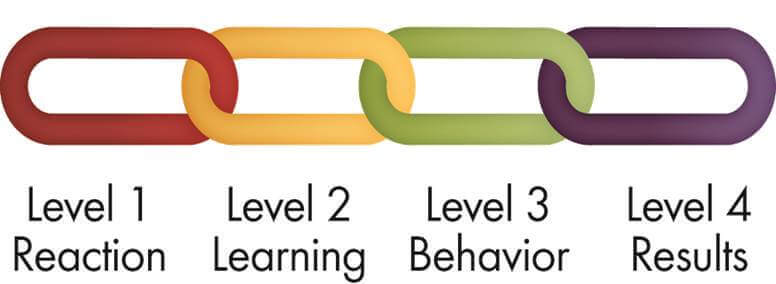
The Kirkpatrick Model is an evaluation framework organized around four levels of impact: reaction, learning, behavior, and results. It was developed more than 50 years ago by Jim’s father, Dr. Don Kirkpatrick, specifically for evaluating training initiatives in business settings. For decades, it has been widely believed that the four levels are applicable only to evaluating the effectiveness of corporate training programs. However, we and hundreds of global “four-level ambassadors” — including Lori Wingate and her colleagues at EvaluATE — have successfully applied Kirkpatrick outside of the typical “training” box. The Kirkpatrick Model has broad appeal because of its practical, results-oriented approach.
The Kirkpatrick Model provides the foundation for evaluating almost any kind of social, business, health, or education intervention. The process starts with identifying what success will look like and driving through with a well-coordinated, targeted plan of support, accountability, and measurement. It is a framework for demonstrating ultimate value through a compelling chain of evidence.

Whether your Advanced Technological Education (ATE) grant focuses on enhancing a curricular program, providing professional development to faculty, developing educational materials, or serving as a resource and dissemination center, the four levels are relevant.
At the most basic level (Level 1: Reaction), you need to know what your participants think of your work and your products. If they don’t value what you’re providing, you have little chance of producing higher-level results.
Next, it’s important to determine how and to what extent participants’ knowledge, skills, attitudes, confidence, and/or commitment changed because of the resources and follow-up support you provided (Level 2: Learning). Many evaluations, unfortunately, don’t go beyond Level 2. But it’s a big mistake to assume that if learning takes place, behaviors change and results happen. It’s critical to determine the extent to which people are doing things differently because of their new knowledge, skill, etc. (Level 3: Behavior).
Finally, you need to be able to answer the question “So what?” In the ATE context, that means determining how your work has impacted the landscape of advanced technological education and workforce development (Level 4: Results).
The four levels are the foundation of the model, but there is much more to it. We hope you’ll take the time to examine and reflect on how this approach can bring value to your initiative and its evaluation. To learn more about Kirkpatrick, visit our website or kirkpatrickpartners.com, where you’ll find a wealth of free resources, as well as information on our certificate and certification programs.
Want to learn more about this topic? View EvaluATE’s webinar ATE Evaluation: Measuring Reaction, Learning, Behavior, and Results.

Except where noted, all content on this website is licensed under a Creative Commons Attribution-NonCommercial-ShareAlike 4.0 International License.






 EvaluATE is supported by the National Science Foundation under grant numbers 0802245, 1204683, 1600992, and 1841783. Any opinions, findings, and conclusions or recommendations expressed on this site are those of the authors and do not necessarily reflect the views of the National Science Foundation.
EvaluATE is supported by the National Science Foundation under grant numbers 0802245, 1204683, 1600992, and 1841783. Any opinions, findings, and conclusions or recommendations expressed on this site are those of the authors and do not necessarily reflect the views of the National Science Foundation.